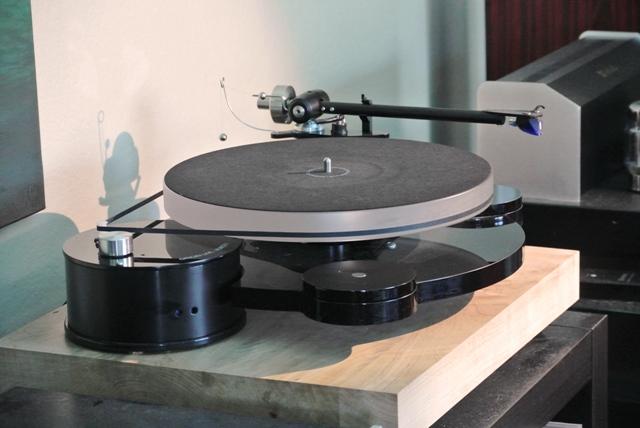The Aurora was the company’s first turntable, and it cost little under £1,000 when it was released in 2014. It’s a high-quality skeletal belt drive design hewn from black acrylic with a low-resonance platter, just like the original from 2003. It lacks traditional sprung suspension and must be placed on a well-isolated table or wall shelf by the user. The main chassis comes with an armboard that is pre-drilled for both Origin Live/old-style Rega single-point and current Rega three-point fixes, which covers a lot of ground; various armboard templates are also available.
The platter and the motor make up the rest of the deck. The bearing hub must be lowered down into the depression on the chassis before the former can be installed – the former is stated to be a new type engineered for faster energy transmission and lower friction than before. Six drops of the supplied “special” oil must be poured before the bearing may be left, and the dot on the spindle assembly must be lined up with the dot on the platter, apparently because the latter is balanced. The new, thicker platter is comprised of a visually appealing semi-translucent acrylic material that designer Mark Baker will not share the exact composition of for commercial reasons. The company’s superb ‘upgrade platter mat’ sits above this, and it’s a great improvement for other decks as well.
Finally, the belt is attached and the motor is slid into the back left chassis recess. Surprisingly, this is a hefty affair rather than the thin and/or thread kind that many other manufacturers like. According to Origin Live, the belt is composed of a new material that has been hand polished for greater quality. The engine unit is quite huge, and the newer Mk3 Aurora is supposed to have improved damping. Inside is a new ironless DC motor with no ‘cogging’ effect, according to the manufacturer. This connects to the offboard power box, which is also believed to have been enhanced. The speed may be simply altered between 33rpm and 45rpm (78rpm is also available on request), and the power is supplied by a low-noise regulated power source.
Because it is a non-sprung design, it will always be more subject to vibrations than a sprung subchassis deck, although the Aurora proved to be less susceptible to the outside world than, example, a Rega. Overall, I was thrilled with the new Aurora’s build quality; the plinth, platter, and bearing hub are all well crafted, and everything fits together seamlessly. The only drawback is that the engine on-off switch isn’t as sleek and sophisticated as it may be. Its important statistics are 450x380x130mm, and it weighs 10.5kg when fully completed.
Despite the fact that the new deck isn’t unrecognizable from the previous one, Mark Baker claims that upgrading your Mk1 or 2 Aurora to Mk3 spec isn’t doable because so many parts have been changed. If you prefer, you can always part-exchange your old deck for the new one, either directly through Origin Live or through your providing dealer. Finally, if you want to employ geometrically correct pick-up arms, the Aurora includes a 12 tonearm mounting option (£260) as well as the option of running dual armboards (£323) instead of simply one. The company’s £450 Onyx arm was mounted to the test sample.
It mixes the natural, warm, and cossetting ambience of vinyl with a considerable bit of insight and grip. It has the Origin Live house sound. As a result, unlike other competing systems that can come ‘on song’ with certain sorts of music, it works well with a wide range of program material. Put on some great jazz like Herbie Mann’s cover of Summertime, for example, and everything good about this deck comes through. The deck was able to cut through the noise on my worn-out LP and get right to the music. The soundstage was quite large, indicating that this was a roomy and engulfing performer.
The Origin Live deck allowed the recording’s rhythm to freely ebb and flow. Jazz is a fantastic example of this, with the performers hovering around the rhythm generating much of the mesmeric effect. Sadly, CD players – and even lower-end turntables – tend to lose this ‘sixth sense’ of the music’s rhythm, but not the Aurora. Instead, I could hear Mann’s flute piece sliding around and subtly accentuating the melody with its lovely phrasing. It’s subtleties like this that separates the wheat from the chaff when it comes to vinyl spinning, and this turntable excelled at it. Another plus is its tonality, which is a touch richer than competition decks — not by much, but enough to make it a better match for inexpensive tonearms that are sometimes harsh.
This deck can take on anything thanks to its natural, well-judged tonality and spontaneous sense of rhythm. I then felt the urge to get some air circulating around the room, so I summed up an original 1977 pressing of Led Zeppelin’s Houses of the Holy. The Rain Song has a great, long, slow build up during which the Aurora demonstrated its excellent detail retrieval; guitars had an almost palpable presence to them, and Robert Plant’s vocal grain was hauntingly lifelike. When the music got into a groove and the levels went higher, this deck hung on tight; it maintained its calm during peaks and kept everything together in terms of pitch as well. Classical music was also enjoyable. Turntables don’t really sing with orchestra music until you spend £500 or more, in my opinion, but the Aurora was well capable of eking out all the detail from the back of the auditorium.
It’s difficult to think of anything else you could want of this £1,000 turntable; its build quality is great for the price, its sound performance is excellent, and it has no flaws in terms of appearance. In the ‘cheap high end’ vinyl spinning stakes, this is a strong contender!






